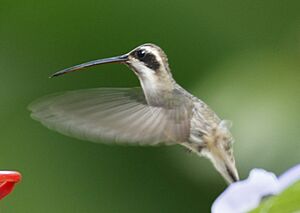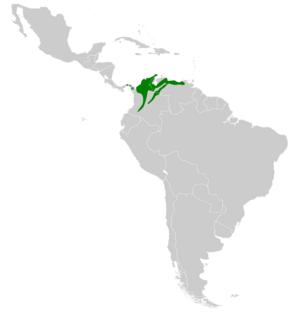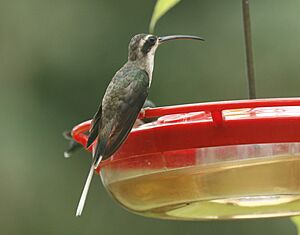Pale-bellied hermit facts for kids
Quick facts for kids Pale-bellied hermit |
|
|---|---|
 |
|
| Canopy Camp – Darien, Panama | |
| Conservation status | |
| Scientific classification | |
| Genus: |
Phaethornis
|
| Species: |
anthophilus
|
 |
|
The pale-bellied hermit (Phaethornis anthophilus) is a small, fast-flying hummingbird. You can find this bird in countries like Colombia, Panama, and Venezuela. It belongs to the Trochilidae family, which is the hummingbird family.
Contents
About the Pale-bellied Hermit
What's in a Name?
Scientists group living things into categories. The pale-bellied hermit is part of a large group called Phaethornis. This group includes many types of hermit hummingbirds. For a while, some thought it was so unique it needed its own group, Ametrornis.
This bird has two main types, called subspecies. They are P. a. anthophilus and P. a. hyalinus. Sometimes, scientists suggest a third type, P. a. fuscicapillus. This shows how scientists are always learning more about animals!
How to Spot a Pale-bellied Hermit
The pale-bellied hermit is about 13 cm (5.1 in) long. That's about the length of a pen! Males usually weigh between 4.5 to 5.5 g (0.16 to 0.19 oz). Females are a little lighter, weighing 4 to 5 g (0.14 to 0.18 oz).
This hummingbird has dark green or olive green feathers on its back. Its belly is a light gray color. Its face has a black "mask" like a superhero! Above its eye, it has a buffy (light yellowish-brown) stripe. Its throat is mostly white.
Male pale-bellied hermits have a bill that is almost straight. Female birds have a bill that curves downwards a bit. The P. a. hyalinus type has more bluish-green on its back and lighter underparts. The suggested P. a. fuscicapillus type has shorter wings and bills than the others.
Where They Live
The pale-bellied hermit lives in several places. The main type, P. a. anthophilus, is found in central Panama. It also lives in northern, central, and eastern Colombia. You can also find it in western and northern Venezuela.
The suggested P. a. fuscicapillus type lives in Colombia's Eastern Andes mountains. It might also include the birds found in Venezuela. The P. a. hyalinus type lives only on the Pearl Islands. These islands are off the Pacific coast of Panama.
These hummingbirds like to live in semi-deciduous forests. These are forests where some trees lose their leaves. They also live in drier woodlands, secondary forest (forests that have grown back), and even plantations. You might see them in brushy or thorny areas too. They can live from sea level up to about 1,500 m (4,900 ft) high.
Life and Habits
Movement and Travel
Scientists have seen some pale-bellied hermits moving around in northeastern Venezuela. This suggests they might travel regularly. However, more studies are needed to understand their movements fully.
What They Eat
The pale-bellied hermit is a "trap-line" feeder. This means it flies a regular path, visiting many different flowering plants. It drinks nectar from these flowers, just like other hermit hummingbirds. They also eat small arthropods, which are tiny insects and spiders.
Reproduction and Nests
The breeding times for the pale-bellied hermit can be different depending on where they live. Scientists are still learning about their full breeding seasons.
Like many other hummingbirds in its group, it builds a cone-shaped nest. It hangs this nest under a drooping leaf, which helps to hide it. A female pale-bellied hermit usually lays two eggs at a time.
Their Calls
The song of the pale-bellied hermit has not been fully described by scientists. However, their calls are known to be "rather piercing, high-pitched notes."
Conservation Status
The IUCN (International Union for Conservation of Nature) has looked at the pale-bellied hermit. They have assessed it as being of "Least Concern." This means it's not currently in danger of disappearing. However, we don't know exactly how many of these birds there are or if their numbers are changing.
The pale-bellied hermit is not rare in most places it lives. In some areas, it's quite common. It also lives in several protected areas, which helps keep them safe.



